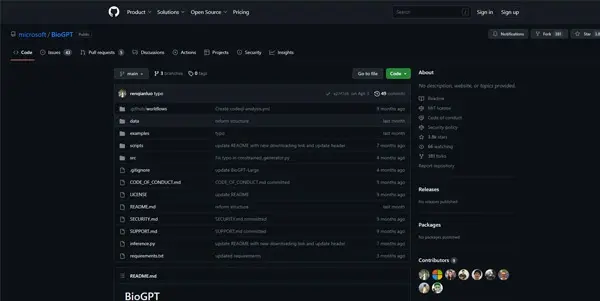BioGPT

An AI under GPT that has been trained with biology concepts in order to help the BioMedical sector
BioGPT: A Deep Dive into the AI Revolutionizing Biomedical Research
BioGPT represents a significant advancement in applying large language models (LLMs) to the field of biomedicine. Built upon the GPT architecture, BioGPT leverages its powerful capabilities to process and understand complex biological information, offering a novel approach to tackling various challenges within the biomedical sector. This article explores its functionalities, applications, and comparison to similar tools.
What BioGPT Does
BioGPT is an AI tool trained on a massive dataset of biological literature and data. This allows it to perform a range of tasks related to biological sequence analysis, protein structure prediction, drug discovery, and more. Essentially, it acts as an intelligent assistant, capable of understanding and generating biological text, extracting relevant information from vast databases, and assisting researchers in their daily tasks. Its strength lies in its ability to synthesize information across diverse biological sources, offering insights that might be missed through traditional manual methods.
Main Features and Benefits
- Biological Text Understanding and Generation: BioGPT can analyze complex biological texts, such as research papers and databases, extracting key information and summarizing findings. It can also generate novel text based on its training data, creating summaries, reports, and even hypotheses.
- Sequence Analysis: The model can analyze biological sequences (DNA, RNA, proteins), identifying patterns, predicting functions, and aiding in the design of new sequences.
- Drug Discovery Support: BioGPT can assist in drug discovery by predicting drug-target interactions, suggesting potential drug candidates, and analyzing experimental data.
- Literature Review and Knowledge Synthesis: Researchers can leverage BioGPT to quickly sift through vast amounts of literature, identifying relevant studies and synthesizing information for their research.
- Data Mining and Interpretation: The tool can help extract and interpret data from various sources, including experimental results, clinical trials, and genomic databases.
Use Cases and Applications
BioGPT's applications are diverse and span many areas of biomedicine:
- Genomics Research: Analyzing genomic sequences, identifying disease-related mutations, and predicting gene function.
- Proteomics Research: Understanding protein structure and function, predicting protein-protein interactions, and aiding in protein engineering.
- Drug Discovery and Development: Identifying potential drug targets, predicting drug efficacy and toxicity, and designing new drugs.
- Biomedical Education: Assisting in teaching and learning of complex biological concepts.
- Clinical Research: Analyzing clinical data to identify trends and patterns, and predicting patient outcomes.
Comparison to Similar Tools
While other AI tools exist for biomedicine, BioGPT distinguishes itself through several key aspects: (Specific comparisons require knowing the exact model details and competing tools, this section is generalized). Its specific training dataset and architecture likely provide superior performance in certain areas, such as complex biological text understanding or specific sequence analysis tasks. A direct comparison necessitates benchmarking against competing LLMs specifically trained for biomedicine. Furthermore, the open-source nature (assuming it's open-source) grants accessibility, enabling broader community contributions and improvements.
Pricing Information
BioGPT is currently available for free. This open access fosters collaboration and allows a wider community to benefit from its capabilities. However, future commercial applications or access to advanced features might entail a change in pricing.
Disclaimer: The specific capabilities and performance of BioGPT may vary depending on the version and the specific tasks performed. It's crucial to consult the official documentation and resources for the most up-to-date information.